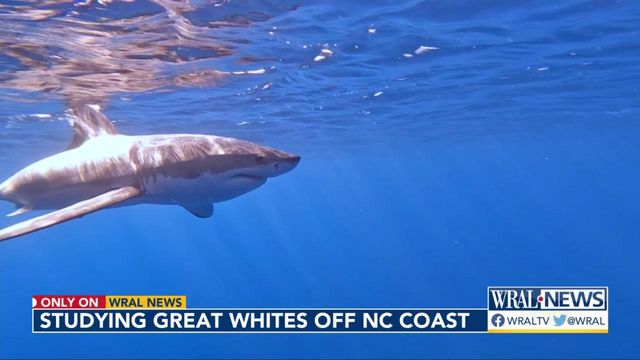Migrating great white sharks off NC coast could provide final piece of puzzle to help oceans thrive
Researchers with Ocearch just wrapped their latest great white shark expedition off the North Carolina coast.
Scientists hope to find out why the predators congregate off our coast this time of year and more importantly, what they’re doing while paying North Carolina a visit.
"Everything’s a go. Possibly 8-to-9 foot long," said expedition leader Chris Fischer about one of their catches. "We have seen sharks every day."
Fischer and a team of scientists from around the world hope the information they've gathered can solve a 2,000-mile puzzle about how great whites move up and down the East Coast.
"We’re really trying to see what the animals are doing while they are here," Fischer says of the latest expedition. The research group has already studied great whites in the northeast and south of here.
Many people know about Ocearch because of their shark tracker. Every time a shark is caught, the animal is equipped with a global positional system. When the shark’s fin is above water, scientists and shark enthusiasts can follow its patch.
At one point in late April, a half-dozen white sharks tagged by Ocearch were pinging off our coast.
"Because it’s getting too hot in the southern part of the range and it’s too cold around Cape Hatteras, so they kind of get pinched up into this region," Fischer explains.
The group had luck early on, despite some bad weather.
Fischer told us, "so far we’ve sampled, captured and worked up and released four great white sharks ranging between 8½ and 13½ feet."
Each shark is given a name to help keep track. During the early part of the expedition, the sharks included 9’3," 425-pound Anne Bonny; 9’7," 430-pound Ocracoke; 10’3," 522-pound Penny and the massive Umi, who is 13’3," and weighs 1,225 pounds. They were each caught 10-to-15 miles off the Outer Banks.
For Fischer, the bigger the better, since sharks need to be 20 years old before they mate. Those big sharks could provide a landmark discovery.
"This mating site, if we can locate it, will be the first mating site in the world ever identified for a white shark population. So it’s hugely important for this region," Fischer says.
Understanding how and where these predators move, eat, mate and give birth can help the entire fish population.
"The description of the white shark is the balance keeper of that whole system," Fischer explains.
While the recent surge in shark sightings in the Cape Cod area sparked fear, Fischer said they’re actually keeping the area’s growing seal population from eating the catch of recreational fisherman.
"One white shark swimming up and down the beach in front of all those seals prevents all of those seals from going into the water to over-forage," he says.
And with the overall fish population thriving compared to a couple of decades ago, Fischer has a bold prediction about our coast.
"The gray seal, believe it or not, in its historic range is going to stretch all the way down here as far south as Cape Hatteras," Fischer expects. "In the next 10 or 20 years they’re going to be back down here in the Carolinas."
Those seals will likely bring more white sharks to our shores.
While that’s something a lot of people don’t want hear, Fischer says the alternative won’t make people happy either.
"The big sharks are actually the guardian of our fish stocks in a healthy and abundant system, which we’re returning to. So if they’re not thriving, we’re not eating fish."










